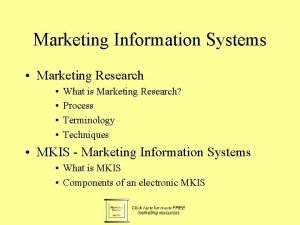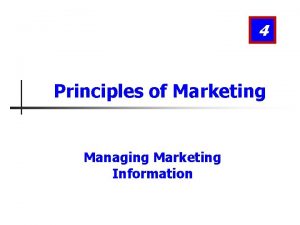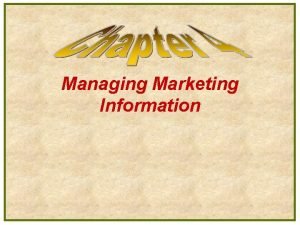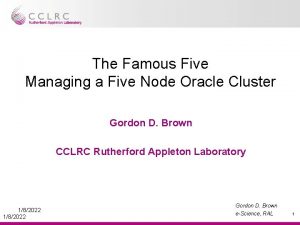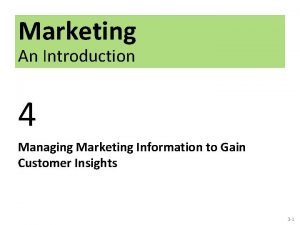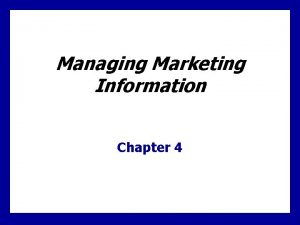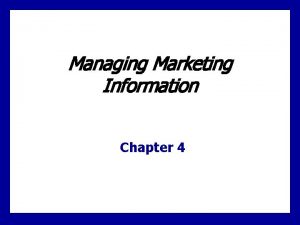Marketing An Introduction Managing Marketing Information Chapter Five













- Slides: 13

Marketing: An Introduction Managing Marketing Information • Chapter Five • Lecture Slides –Express Version • Course • Professor • Date ©Copyright 2004, Pearson Education Canada Inc.

Marketing: An Introduction Looking Ahead • After studying this chapter, you should be able to: • Explain the importance of information to the company • Define the marketing information system and discuss its parts • Outline the steps in the marketing research process • Explain how companies analyze and distribute marketing information • Discuss the special issues some marketing researchers face, including public policy and ethics issues 2 ©Copyright 2004, Pearson Education Canada Inc.

Marketing: An Introduction The Marketing Information System • The people, equipment, and procedures needed to gather, sort, analyze, evaluate, and distribute needed, timely, and accurate information to marketing decision makers. • The importance of information? – – To cope with rapidly changing environments To remain competitive To make better decisions To follow the marketing concept • The challenge: to get not more, but better information to make marketing decisions with 3 ©Copyright 2004, Pearson Education Canada Inc.

Marketing: An Introduction Marketing Managers and Other Information Users Analysis Planning Implementation Organization Control Marketing Information System Developing needed information Assessing Information needs Target Markets 4 Internal databases Information analysis Marketing intelligence Marketing research Distributing and using information Marketing Environment Marketing Competitors Publics Macrochannels environment forces 2004 Pearson Education Canada Inc. Figure 5 -1

Marketing: An Introduction Developing Marketing Information • Internal data: – Internal databases store information – Collected from different functions within the company – The challenge is to integrate and make usable • Marketing intelligence: a systematic collection and analysis of publicly available information about the competitors and developments in the marketing environment – Online databases provide this information for a fee – Potential ethical issues 5 2004 Pearson Education Canada Inc.

Marketing: An Introduction Developing Marketing Information • Marketing research: the systematic design, collection, analysis, and reporting of data relevant to a specific situation facing an organization • Steps in the research process: – Defining the problem and setting the research objectives – Gathering primary and secondary data – Developing a research plan – Implementing the marketing research plan – Interpreting and reporting the findings 6 2004 Pearson Education Canada Inc.

Marketing: An Introduction Types of Marketing Research • Exploratory research: marketing research to gather preliminary information that will help define problems and suggest hypotheses – Focus group discussions, personal interviews – Gathering of secondary data • Descriptive research: marketing research to better describe marketing problems, situations, or markets – Surveys, observational studies • Causal research: marketing research to test hypotheses about cause-and-effect relationships between variables of interest. – Experiments in controlled conditions 7 2004 Pearson Education Canada Inc.

Marketing: An Introduction Sources of Secondary Data • Government publications – Statistics Canada, strategis. gc. ca • Periodicals and books – Trade directories, indexes, and industry surveys • Commercial data services – Collections of business research articles – Industry and scanner data – Credit reports • International data • Internet data sources – Search engines – Industry websites 8 2004 Pearson Education Canada Inc.

Marketing: An Introduction Comparison of Contact Methods Mail Telephone Personal Flexibility Poor Good Excellent Quantity of data that can be collected Good Fair Excellent Fair Poor Control of sample Fair Excellent Fair Speed of data collection Poor Excellent Good Response rate Poor Good Cost Good Fair Poor Control of interviewer effect 9 2004 Pearson Education Canada Inc. Table 5 -3

Marketing: An Introduction Types of Samples • Sample: a segment of the population selected to represent the population as a whole – Who is to be surveyed? – How many people should be surveyed? – How should those surveyed be chosen? • Probability sample – Simple random sample – Stratified random sample • Nonprobability sample – Convenience sample – Judgment sample 10 2004 Pearson Education Canada Inc.

Marketing: An Introduction Analyzing Marketing Information • Customer relationship management (CRM): sophisticated software and analytical tools that integrate customer information from all sources, analyze it in depth, and use the results to build stronger customer relationships. – Capturing information at every customer touchpoint – Integration of different company functions and departments is necessary – Use of data warehouses – Use of data mining techniques – Can be expensive but worth it 11 2004 Pearson Education Canada Inc.

Marketing: An Introduction Issues Marketing Researchers Face • Small businesses and nonprofit organizations – – • International marketing research – – • Cultural differences need to be addressed Language, literacy rates, attitudes towards marketing Public policy and ethical issues – – – 12 Lack the resources to conduct large-scale research Can use observational and survey research Intrusions on consumer privacy Misuse of research findings Both Canadian Marketing Association and Professional Marketing Research Society publish code of ethics 2004 Pearson Education Canada Inc.

Marketing: An Introduction Looking Back • Importance of information • The marketing information system • Steps in the research process • Analyzing and distributing marketing information • Special issues facing researchers 13 ©Copyright 2004, Pearson Education Canada Inc.
 Despite the data glut that marketing managers
Despite the data glut that marketing managers Importance of rest
Importance of rest Managing marketing information
Managing marketing information Five years have past five summers with the length
Five years have past five summers with the length Five of five
Five of five 5 elements and 5 senses
5 elements and 5 senses Dew the sovereign flower and drown the weeds
Dew the sovereign flower and drown the weeds Managing and using information systems
Managing and using information systems Arrangements for managing information between professionals
Arrangements for managing information between professionals Information technology resource management
Information technology resource management Management information system managing the digital firm
Management information system managing the digital firm Management information systems managing the digital firm
Management information systems managing the digital firm Finer segmentation
Finer segmentation Marketing information systems and marketing research
Marketing information systems and marketing research













